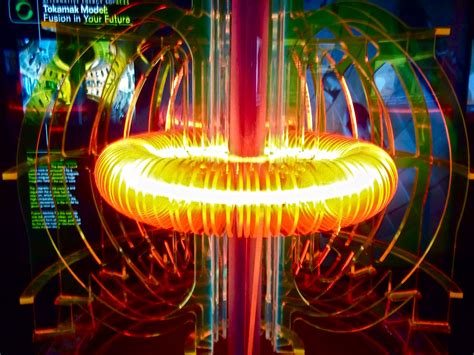
Scientists are edging closer to achieving sustained nuclear fusion, a potential limitless and clean energy source, with recent advancements in plasma control and confinement. Researchers are reporting progress in overcoming key hurdles that have long hampered the development of practical fusion reactors, raising hopes that fusion energy could become a reality in the coming decades.
The quest for fusion energy, often described as trying to “bottle a star,” hinges on replicating the process that powers the sun: forcing hydrogen atoms to fuse together at extremely high temperatures, releasing vast amounts of energy. While scientists have achieved fusion in the lab, sustaining the reaction long enough to generate more energy than it consumes has remained a significant challenge.
“Fusion is a very attractive energy source because it is inherently safe, produces no greenhouse gasses, and the fuel is abundant,” stated Dr. Melanie Windridge, a fusion energy consultant and author, in a recent interview. She emphasized the potential transformative impact of fusion on the global energy landscape.
Several approaches to fusion are being explored worldwide, including magnetic confinement fusion, which uses powerful magnets to contain superheated plasma, and inertial confinement fusion, which uses lasers to compress and heat fuel pellets. The most promising magnetic confinement device is the tokamak, a doughnut-shaped reactor.
The Joint European Torus (JET) in the UK, a tokamak device, recently achieved a record-breaking 59 megajoules of sustained fusion energy. This result, while not energy positive, demonstrated significant progress in plasma control and confinement. “These landmark results have taken us a huge step closer to conquering one of fusion’s biggest challenges,” said Dr. Tony Donne, EUROfusion Programme Manager, following the JET experiment.
The International Thermonuclear Experimental Reactor (ITER), currently under construction in France, is designed to be the world’s largest tokamak and aims to demonstrate the scientific and technological feasibility of fusion energy. ITER is expected to produce 500 megawatts of fusion power from 50 megawatts of input heating power, a tenfold energy gain.
In addition to tokamaks, other fusion concepts are gaining traction, including stellarators, which use more complex magnetic fields to confine plasma, and various private sector initiatives pursuing innovative approaches. The private sector is investing heavily in fusion research, with companies like Commonwealth Fusion Systems and TAE Technologies attracting significant funding.
Despite the progress, significant challenges remain. These include developing materials that can withstand the intense heat and neutron bombardment inside a fusion reactor, optimizing plasma stability and confinement, and reducing the cost of fusion energy to make it competitive with other energy sources.
Dr. Windridge acknowledges the remaining hurdles but expresses optimism: “There are still significant engineering challenges to overcome, but the progress in recent years has been remarkable. Fusion is no longer a distant dream; it is a tangible goal within reach.”
The potential benefits of fusion energy are immense. It offers a virtually limitless supply of energy, using fuels derived from seawater and lithium. Fusion reactions produce no greenhouse gasses, contributing to the fight against climate change. Fusion reactors are inherently safe, with no risk of runaway reactions like those in fission reactors. Furthermore, fusion produces minimal radioactive waste, and the waste products have relatively short half-lives compared to fission waste.
The development of fusion energy could revolutionize the global energy system, providing a clean, sustainable, and abundant energy source for future generations. While challenges remain, the recent progress in fusion research is fueling optimism that this transformative technology could become a reality in the coming decades.
In-Depth Analysis: The Science and Challenges of Nuclear Fusion
Nuclear fusion, the process that powers the sun and stars, holds the promise of becoming a clean, safe, and virtually limitless source of energy for humanity. Unlike nuclear fission, which involves splitting heavy atoms like uranium, fusion involves forcing light atoms, typically isotopes of hydrogen, to combine at extremely high temperatures and pressures. This process releases vast amounts of energy, as a small amount of mass is converted into energy according to Einstein’s famous equation, E=mc².
The most common fusion reaction being pursued for energy production involves deuterium and tritium, both isotopes of hydrogen. Deuterium is abundant in seawater, while tritium can be produced from lithium, a relatively common element. When deuterium and tritium fuse, they form helium and a neutron, releasing 17.6 MeV (mega-electron volts) of energy.
To achieve fusion, the fuel must be heated to temperatures exceeding 100 million degrees Celsius, hotter than the sun’s core. At these temperatures, the fuel becomes plasma, a state of matter where electrons are stripped from atoms, creating a soup of ions and free electrons. Containing and controlling this plasma is one of the greatest challenges in fusion research.
Magnetic Confinement Fusion: Taming the Plasma
The most widely pursued approach to magnetic confinement fusion involves the tokamak, a toroidal (doughnut-shaped) device that uses powerful magnetic fields to confine the plasma. The magnetic field lines spiral around the torus, preventing the charged particles from escaping and colliding with the walls of the reactor.
The tokamak concept was developed in the 1950s by Soviet scientists Andrei Sakharov and Igor Tamm. The first tokamak, the T-1, was built at the Kurchatov Institute in Moscow and demonstrated promising results in the 1960s. Since then, tokamaks have been built and operated around the world, including the Joint European Torus (JET) in the UK, the Tokamak Fusion Test Reactor (TFTR) in the US, and the JT-60 in Japan.
JET, currently the world’s largest operating tokamak, has achieved several important milestones in fusion research. In 1997, JET produced 16 megawatts of fusion power. In 2022, JET achieved a record-breaking 59 megajoules of sustained fusion energy, demonstrating significant progress in plasma control and confinement. These experiments used a deuterium-tritium fuel mixture, the same fuel that will be used in future fusion power plants.
The International Thermonuclear Experimental Reactor (ITER), currently under construction in France, represents the next major step in tokamak development. ITER is designed to be the world’s largest tokamak and aims to demonstrate the scientific and technological feasibility of fusion energy. ITER is expected to produce 500 megawatts of fusion power from 50 megawatts of input heating power, a tenfold energy gain, demonstrating the potential for a self-sustaining fusion reaction.
Inertial Confinement Fusion: Lasers and Fuel Pellets
Inertial confinement fusion (ICF) is another approach to achieving fusion. ICF uses powerful lasers or particle beams to compress and heat tiny fuel pellets to the extreme conditions required for fusion. The fuel pellet is rapidly compressed, increasing its density and temperature until fusion occurs.
The most prominent ICF facility is the National Ignition Facility (NIF) at the Lawrence Livermore National Laboratory in California. NIF uses 192 high-energy lasers to compress and heat a small target containing deuterium and tritium fuel. In December 2022, NIF achieved a significant milestone by demonstrating “scientific breakeven,” producing more energy from fusion than the laser energy delivered to the target. This was a major breakthrough, confirming the basic physics of ICF and opening new possibilities for fusion energy research.
While NIF’s achievement was a significant step forward, it is important to note that it only considered the energy delivered to the target, not the total energy consumed by the lasers and facility. To be a viable energy source, ICF will need to improve the efficiency of the lasers and the overall energy gain of the process.
Beyond Tokamaks: Alternative Fusion Concepts
While tokamaks are the most mature fusion concept, other approaches are being explored, each with its own advantages and challenges.
- Stellarators: Stellarators are similar to tokamaks, but they use more complex magnetic fields to confine the plasma. Stellarators are designed to be inherently stable, meaning they do not require external feedback control to maintain plasma confinement. However, the complex magnetic field coils of stellarators are difficult to design and build. The Wendelstein 7-X stellarator in Germany is one of the most advanced stellarators in the world.
- Magnetized Target Fusion (MTF): MTF combines aspects of both magnetic and inertial confinement fusion. In MTF, a plasma is first confined by a magnetic field and then compressed by a mechanical liner or a laser-driven implosion.
- Field-Reversed Configuration (FRC): FRC devices create a self-organized magnetic field structure that confines the plasma. FRCs have the potential to be more compact and efficient than tokamaks.
- Beam-Driven Fusion: This approach uses beams of ions or neutral particles to heat and drive fusion reactions in a target plasma.
Challenges and Opportunities: The Path to Fusion Energy
Despite the significant progress in fusion research, several challenges remain before fusion energy can become a commercial reality.
- Plasma Stability and Confinement: Maintaining stable and well-confined plasma is crucial for achieving sustained fusion. Plasma instabilities can lead to disruptions, which can damage the reactor and interrupt the fusion reaction. Researchers are working to develop advanced control systems and plasma diagnostics to mitigate these instabilities.
- Materials Science: The materials used to build fusion reactors must withstand extreme conditions, including high temperatures, intense neutron bombardment, and strong magnetic fields. Developing materials that can survive in this harsh environment is a major challenge. Researchers are investigating new materials, such as tungsten alloys and advanced ceramics, for use in fusion reactors.
- Tritium Breeding: Tritium is a radioactive isotope of hydrogen that is used as a fuel in fusion reactors. Tritium is not naturally abundant and must be produced in the reactor itself through a process called tritium breeding. This involves using neutrons from the fusion reaction to bombard lithium, producing tritium. Developing efficient and reliable tritium breeding systems is essential for the long-term viability of fusion energy.
- Cost: The cost of building and operating fusion reactors is currently very high. Reducing the cost of fusion energy to make it competitive with other energy sources is a major challenge. Researchers are working to develop more efficient and cost-effective fusion technologies.
- Public Perception: Public perception of fusion energy is generally positive, but some concerns remain about the safety and environmental impact of fusion reactors. Addressing these concerns and building public support for fusion energy is important for its long-term success.
Despite these challenges, the potential benefits of fusion energy are immense. Fusion offers a virtually limitless supply of energy, using fuels derived from seawater and lithium. Fusion reactions produce no greenhouse gasses, contributing to the fight against climate change. Fusion reactors are inherently safe, with no risk of runaway reactions like those in fission reactors. Furthermore, fusion produces minimal radioactive waste, and the waste products have relatively short half-lives compared to fission waste.
The development of fusion energy could revolutionize the global energy system, providing a clean, sustainable, and abundant energy source for future generations. The recent progress in fusion research, coupled with increasing private sector investment, is fueling optimism that this transformative technology could become a reality in the coming decades.
The Role of Private Sector Investment
In recent years, there has been a surge of private sector investment in fusion energy research. Companies like Commonwealth Fusion Systems, TAE Technologies, and General Fusion are pursuing innovative approaches to fusion, attracting significant funding from venture capitalists and other investors.
Commonwealth Fusion Systems (CFS), a spin-off from MIT, is developing a compact tokamak that uses high-temperature superconducting magnets to achieve stronger magnetic fields and more efficient plasma confinement. CFS has raised over $2 billion in funding and is aiming to build a demonstration fusion power plant by the mid-2020s.
TAE Technologies is pursuing a field-reversed configuration (FRC) approach to fusion. TAE has raised over $1.2 billion in funding and is building a prototype fusion reactor called Copernicus.
General Fusion is developing a magnetized target fusion (MTF) reactor that uses mechanical compression to heat and compress plasma. General Fusion has raised over $300 million in funding and is building a demonstration plant in the UK.
The increasing private sector investment in fusion energy is a positive sign, indicating growing confidence in the potential of fusion technology. Private companies are often able to move faster and take more risks than government-funded research programs, accelerating the pace of innovation in the field.
The Future of Fusion Energy
The future of fusion energy is bright, with significant progress being made on multiple fronts. The ITER project is expected to demonstrate the scientific and technological feasibility of fusion energy. Private sector companies are developing innovative fusion technologies that could accelerate the path to commercial fusion power.
While challenges remain, the potential benefits of fusion energy are too great to ignore. Fusion offers a clean, safe, and virtually limitless source of energy that could transform the global energy system and help address climate change. With continued research and development, fusion energy could become a reality in the coming decades, providing a sustainable energy future for generations to come.
Frequently Asked Questions (FAQ)
1. What is nuclear fusion, and how does it work?
Nuclear fusion is the process of forcing two light atomic nuclei to combine into a single heavier nucleus, releasing a large amount of energy in the process. This is the same process that powers the sun and other stars. In the most common fusion reaction being studied for energy production, two isotopes of hydrogen, deuterium and tritium, are fused to create helium and a neutron, releasing energy. To achieve fusion, the fuel must be heated to extremely high temperatures (over 100 million degrees Celsius) and compressed to high densities, creating a plasma where the atoms are ionized.
2. What are the advantages of fusion energy compared to other energy sources?
Fusion energy offers several significant advantages:
- Virtually limitless fuel: Deuterium can be extracted from seawater, and tritium can be produced from lithium, both of which are abundant resources.
- No greenhouse gas emissions: Fusion reactions do not produce greenhouse gases, making it a clean energy source that can help combat climate change.
- Inherent safety: Fusion reactors are inherently safe because the fusion reaction is difficult to sustain. If any problem occurs, the reaction will simply stop. There is no risk of a runaway reaction like in nuclear fission reactors.
- Minimal radioactive waste: Fusion produces relatively small amounts of radioactive waste, and the waste products have shorter half-lives compared to nuclear fission waste.
3. What are the main challenges in developing fusion energy?
Despite its potential, fusion energy faces several significant challenges:
- Plasma stability and confinement: Maintaining a stable and well-confined plasma at extremely high temperatures is difficult. Plasma instabilities can disrupt the fusion reaction and damage the reactor.
- Materials science: The materials used to build fusion reactors must withstand extreme conditions, including high temperatures, intense neutron bombardment, and strong magnetic fields.
- Tritium breeding: Tritium is a radioactive isotope of hydrogen that is used as a fuel in fusion reactors. It is not naturally abundant and must be produced in the reactor itself through a process called tritium breeding.
- Cost: The cost of building and operating fusion reactors is currently very high.
- Achieving net energy gain: Scientists have been working for decades to design fusion reactors that will produce more energy than they consume. This is called net energy gain, and it has been a major hurdle to overcome.
4. What is ITER, and what is its role in fusion research?
ITER (International Thermonuclear Experimental Reactor) is a large-scale international fusion project under construction in France. It is designed to be the world’s largest tokamak and aims to demonstrate the scientific and technological feasibility of fusion energy. ITER is expected to produce 500 megawatts of fusion power from 50 megawatts of input heating power, a tenfold energy gain. ITER will not generate electricity, but it will provide valuable data and experience for the design and construction of future fusion power plants. The project involves collaboration from several countries and is currently expected to begin operations in the late 2020s.
5. How is the private sector contributing to fusion energy development?
The private sector is playing an increasingly important role in fusion energy development. Several private companies are pursuing innovative approaches to fusion, attracting significant funding from venture capitalists and other investors. These companies are often able to move faster and take more risks than government-funded research programs, accelerating the pace of innovation in the field. Some notable private fusion companies include Commonwealth Fusion Systems, TAE Technologies, and General Fusion. These companies are exploring different fusion concepts and technologies, aiming to build commercially viable fusion power plants.









